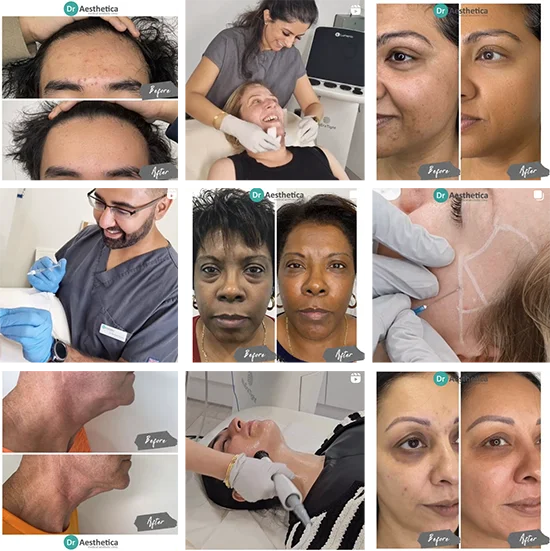.jpg)
Are you tired of struggling with weight loss and worried that it may make you look older? You're not alone. Many people are concerned about the effects of weight loss on their appearance, and for good reason. In this article, we will explore the potential impacts of weight loss on ageing, providing you with the information you need to make informed decisions about your health and appearance.
Why Do People Want To Lose Weight?
People have different motivations for wanting to lose weight. Some people want to improve their general health and reduce the risk of diseases such as diabetes and heart conditions. Others may want to improve their physical appearance and increase their self-confidence. Losing weight can also be motivated by the desire to fit into certain clothes or achieve a specific body shape. In addition, individuals may want to improve their athletic performance or increase their energy levels.
Understanding the personal motivations for weight loss can help individuals set realistic goals and develop effective strategies to achieve them.
What Happens To Your Skin When You Lose Weight?
Losing weight can have significant effects on your skin. When you lose weight, especially rapidly, the skin may not be able to adapt to the changes in body shape and size. This can lead to loose or sagging skin. The amount of loose skin can vary depending on factors such as age, genetics, and the amount of weight lost.
To minimize the impact on your skin, it is important to lose weight gradually and maintain a healthy lifestyle. Additionally, staying hydrated and moisturizing the skin can help improve its elasticity and appearance.
Does Weight Loss Make You Look Older?
Weight loss can impact the appearance of the skin, potentially causing a person to look older. Factors such as muscle loss, dehydration, sun exposure, and poor nutrition can contribute to this effect when losing weight. However, there are tips to reduce the aging effects. These include:
- Staying hydrated
- Maintaining a balanced diet
- Protecting the skin from the sun
- Incorporating strength training exercises
By following these tips, individuals can achieve weight loss while maintaining a youthful appearance of their skin. So, to answer the question "Does weight loss make you look older?" - it can, but with proper care, this can be minimized.
What Are The Other Factors That Can Make You Look Older When Losing Weight?
While losing weight can often lead to a more youthful appearance, there are certain factors that can have the opposite effect. In this section, we will discuss the other factors that can make you look older when losing weight. These include losing muscle mass, dehydration, increased sun exposure, and poor nutrition. By understanding these factors, we can make informed decisions about our weight loss journey and maintain a healthy, youthful appearance.
1. Losing Muscle Mass
Losing muscle mass is a common concern when trying to lose weight. Here are some steps to help prevent muscle loss:
- Incorporate resistance training into your exercise routine to stimulate muscle growth.
- Consume enough protein, aiming for around 0.8-1 gram per pound of body weight.
- Ensure you are in a moderate calorie deficit, not an extreme one, to support muscle maintenance.
- Stay consistent with your workouts and avoid long periods of inactivity.
- Monitor your progress and make adjustments as needed to maintain muscle mass.
2. Dehydration
Dehydration can have negative effects on your skin when losing weight. To avoid these issues, follow these steps:
- Stay hydrated by drinking an adequate amount of water daily.
- Avoid excessive consumption of diuretic substances like caffeine and alcohol.
- Use a moisturiser to keep your skin hydrated from the outside.
- Limit exposure to harsh environmental conditions like extreme heat or cold.
- Avoid prolonged exposure to hot showers or baths.
- Consider using a humidifier in dry indoor environments.
3. Sun Exposure
Excessive sun exposure while losing weight can accelerate the ageing process of the skin. Protecting your skin from harmful UV rays is crucial to maintain a youthful appearance. Here are some steps to minimise the effects of sun exposure during weight loss:
- Apply sunscreen with a high SPF daily, even on cloudy days.
- Wear protective clothing, such as wide-brimmed hats and long sleeves.
- Seek shade during peak sun hours, typically between 10 am and 4 pm.
- Use sunglasses to shield your eyes from the sun's harsh rays.
Following these precautions will help prevent premature ageing and maintain healthy, youthful-looking skin while on a weight loss journey.
4. Poor Nutrition
Poor nutrition is a significant factor that can cause you to appear older when you are trying to lose weight. When you do not consume enough essential nutrients, your body may lack the necessary resources to maintain healthy skin, hair, and overall appearance. In addition, insufficient nutrition can weaken your immune system, making you more prone to illness and slower healing.
To avoid looking older while losing weight, it is important to prioritize a well-balanced diet that includes a variety of fruits, vegetables, lean proteins, whole grains, and healthy fats. This will ensure that your body receives the necessary nutrients for optimal health and vitality.
What Are The Tips To Avoid Looking Older While Losing Weight?
Losing weight can have numerous health advantages, but it can also result in some unintended consequences - one of which is the onset of aging. However, do not let this discourage you from your weight loss journey. In this section, we will discuss a few helpful suggestions to prevent appearing older while shedding pounds. From maintaining hydration to including strength training, we will explore different techniques to ensure that your skin, body, and overall appearance retain a youthful and vibrant look throughout your weight loss journey.
1. Stay Hydrated
Staying hydrated is essential when trying to lose weight in order to maintain healthy skin and prevent premature aging. Here are some steps to stay hydrated while losing weight:
- Drink plenty of water throughout the day. Aim for at least 8 glasses (64 ounces) of water daily.
- Carry a reusable water bottle with you to remind yourself to drink water regularly.
- Incorporate hydrating foods into your diet, such as fruits and vegetables with high water content.
- Avoid excessive consumption of caffeine and alcohol, as they can cause dehydration.
- Monitor the color of your urine. Clear or pale yellow urine indicates proper hydration.
By following these steps, you can ensure that you stay hydrated while losing weight, promoting skin health, and preventing the onset of aging.
2. Eat A Balanced Diet
To avoid appearing older while losing weight, it is important to follow a balanced diet that provides essential nutrients to maintain healthy skin. Here are some steps to incorporate a balanced diet into your weight loss journey:
- Include a variety of fruits and vegetables in your meals to ensure an adequate intake of vitamins and antioxidants.
- Incorporate lean proteins, such as poultry, fish, and legumes, to support muscle maintenance and promote skin elasticity.
- Choose whole grains, like brown rice and quinoa, for a good source of fiber and nutrients.
- Include healthy fats, such as avocados and nuts, to nourish your skin and enhance its natural glow.
- Stay hydrated by drinking plenty of water throughout the day to maintain skin moisture and elasticity.
By following these steps and maintaining a balanced diet, you can support your overall health and minimize the effects of weight loss on your skin, helping you maintain a youthful appearance.
3. Protect Your Skin From The Sun
Proteger votre peau du soleil est essentiel pendant la perte de poids pour prévenir le vieillissement prématuré et les dommages cutanés.
- Appliquer de la crème solaire : Utilisez une crème solaire à large spectre avec un indice de protection solaire (SPF) d'au moins 30 et appliquez-la généreusement sur toutes les zones exposées de votre peau.
- Chercher l'ombre : Évitez l'exposition directe au soleil pendant les heures de pointe (de 10h à 16h) lorsque les rayons du soleil sont les plus forts.
- Porter des vêtements de protection : Couvrez votre peau avec des vêtements, des chapeaux et des lunettes de soleil pour la protéger des rayons UV nocifs.
- Utiliser un baume à lèvres : Appliquez un baume à lèvres avec une protection solaire pour protéger vos lèvres des dommages causés par le soleil.
- Réappliquer de la crème solaire : N'oubliez pas de réappliquer de la crème solaire toutes les deux heures, surtout après avoir nagé ou transpiré.
4. Incorporate Strength Training
Incorporating strength training into your weight loss journey can help prevent muscle loss and maintain a youthful appearance. Here are some steps to incorporate strength training effectively:
- Start with a warm-up: Begin each session with a few minutes of light cardio to prepare your body.
- Choose the right exercises: Focus on compound movements that target multiple muscle groups, such as squats, deadlifts, and push-ups.
- Gradually increase intensity: As you become comfortable with the exercises, gradually increase the weight or resistance to challenge your muscles.
- Aim for consistency: Incorporate strength training at least 2-3 times per week to see significant results.
- Listen to your body: Pay attention to any discomfort or pain during the exercises and modify or seek guidance if needed.
- Don't forget to stretch: After each strength training session, include stretching exercises to improve flexibility and prevent injury.
- Track your progress: Keep a record of your exercises, sets, and reps to track your progress over time.
Frequently Asked Questions
Does weight loss make you look older?
Yes, it can. When you lose a significant amount of weight, it can cause your skin to sag and create wrinkles, making you appear older than you actually are.
Why does weight loss make you look older?
Weight loss can make you look older because it causes your skin to lose its elasticity. This leads to sagging and wrinkles, which are common signs of ageing.
Is it possible to prevent looking older while losing weight?
Yes, there are steps you can take to prevent looking older while losing weight. These include maintaining a healthy diet, staying hydrated, and incorporating strength training exercises to build muscle mass and maintain skin elasticity.
What are some tips for avoiding looking older while losing weight?
Aside from maintaining a healthy diet and staying hydrated, there are other tips you can follow to prevent looking older while losing weight. These include incorporating antioxidant-rich foods, using moisturiser to keep skin hydrated, and getting enough sleep to allow the body to repair itself.
Can losing weight too quickly make you look older?
Yes, losing weight too quickly can make you look older. Rapid weight loss can cause your skin to sag and create wrinkles, leading to a premature aged appearance.
Is there a way to lose weight without looking older?
Yes, there are ways to lose weight without looking older. Gradual weight loss, maintaining a healthy diet, staying hydrated, and incorporating strength training exercises can help prevent a wrinkled, aged appearance while losing weight. It's also important to listen to your body and avoid crash diets or extreme weight loss methods.


